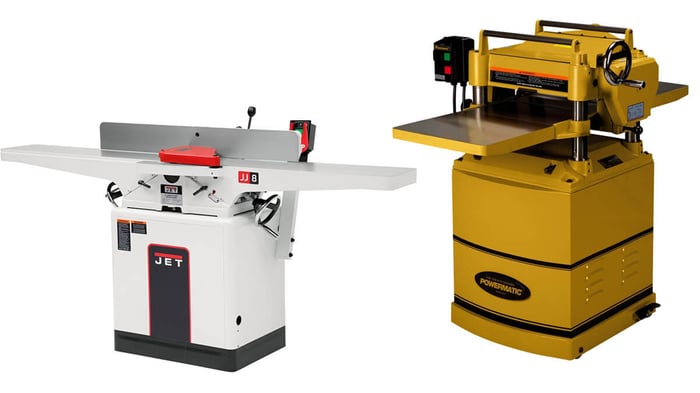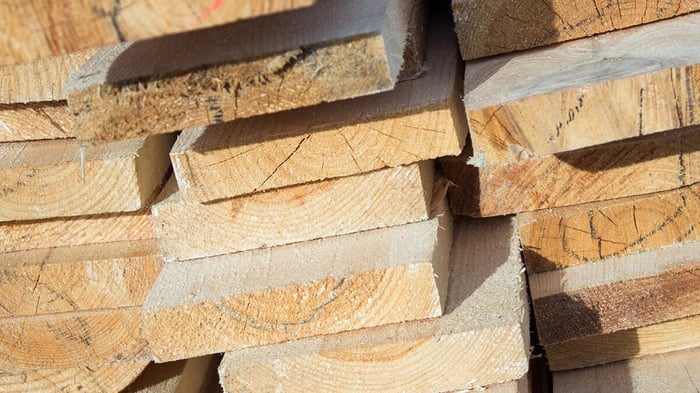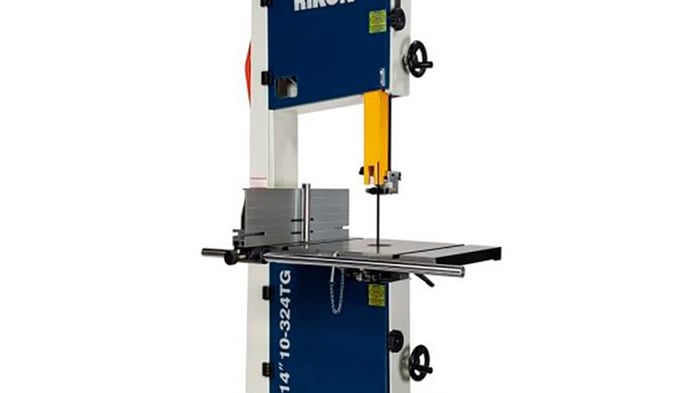
What's the Difference Between Jointers and Planers?
This article is an introductory guide for woodworking beginners to distinguish between jointers and planers. It offers a detailed exploration of the functions of jointers and planers, their operational mechanisms, and the key distinctions between the two tools in terms of their capabilities and types of cuts.
Additionally, it offers advice on selecting the most suitable tool for a woodworking project and on utilizing jointers and planers in a safe manner.
What Are Jointers and Planers?

Jointers and planers are woodworking tools used to prepare wood boards by achieving a flat, smooth surface for various woodworking projects. These tools play a crucial role in woodworking by ensuring that the wood is flat and even, which is essential for producing high-quality final products. A smooth surface enhances both the aesthetics and durability of the wood, making it easier to work with during the woodworking process.
Woodworkers utilize jointers to create straight edges and planers to flatten and smooth rough surfaces, enabling them to make consistent, precise cuts and create seamless joins in their projects. Jointers and planers are essential for crafting furniture, cabinets, and other wood-based items with professional-grade quality.
How Do Jointers and Planers Work?
In jointers and planers, blades powered by a motor rotate at high speeds to cut and smooth the surface of wood boards on a table, ensuring the accuracy and efficiency of woodworking techniques. These blades are responsible for cutting and smoothing the wood boards, eliminating imperfections, and creating a flat surface. The motors to which the blades are attached provide the necessary power to rotate them swiftly and precisely. An adjustable table acts as support for the wood board, allowing it to move steadily and accurately over the rapidly rotating blades. By combining sharp blades, motor power, and a sturdy table, jointers and planers enable woodworkers to achieve the smooth and uniform surfaces essential for their projects.
What Are the Main Differences Between Jointers and Planers?
The main differences between jointers and planers lie in their purposes, cutting depths, cutting widths, techniques used, and types of cuts they can make for woodworking projects.
Jointers are primarily used to flatten one face and square one edge of rough lumber before utilizing a thickness planer. They excel in creating relatively smooth, flat surfaces and squaring edges to facilitate good glue joints.
Planers, on the other hand, focus on achieving a consistent thickness from end to end. Jointers are valuable for edge profiles and rabbiting, while planers are essential for uniformly reducing the thickness of boards.
Note: A planer will "flatten" the top of a board relative to a flat bottom. If your bottom is not flat, the top will not be flat. That's why you use a jointer first, and the planer second.
But, you can't just use a jointer on one side, and then flip your board over to flatten the other side. The board will be flat on both sides, yes, but may be 3/4" thick on one end and 1" on the other. That is why you need a planer, to get an even thickness along the board. That is why planers are sometimes called thicknessers.
Both machines play crucial roles in preparing wood for various woodworking tasks, offering distinct advantages to the overall process.
1. Purpose
The primary function of a jointer is to flatten and straighten the edges of wood boards, ensuring they are parallel and smooth for high-quality woodworking projects. A critical role of the jointer is to create perfectly flat edges that are essential for precise joints between multiple pieces of wood, serving as the initial step in furniture or cabinetry construction.
When multiple wood pieces are joined, flat and smooth edges are necessary to simplify and enhance the assembly process. Generally, the jointer is utilized to flatten and smooth wood surfaces, eliminating imperfections like twists or bends to enhance the wood's aesthetic appeal and professional quality.
2. Cutting Depth
In woodworking, the cutting depth of a planer is crucial for determining the thickness of the wood being processed, while a jointer is used to flatten the wood surface rather than control its thickness.
When setting the cutting depth of a planer, the woodworker must adjust it to achieve the desired final thickness of the board. This precise control over cutting depth ensures uniform thickness across the wood piece, essential for creating smooth and even surfaces at the correct thickness.
On the other hand, jointers are employed to level uneven areas on the board's surface to guarantee it is perfectly flat before going through the planer. The combined use of jointers and planers is essential in woodworking projects as it enables woodworkers to transform rough lumber into uniformly smooth finished pieces.
3. Cutting Width
The primary distinction between jointers and planers lies in their cutting directions and widths. Jointers cut along the edges of boards to create flat and smooth surfaces, while planers cut across the full width of the board. Jointers are essential for producing straight edges and removing imperfections. On the other hand, planers are utilized to ensure uniform thickness across the entire board, making them valuable for reducing the thickness of wood and establishing a level surface for subsequent woodworking projects.
4. Cutting Technique

Jointers and planers employ cutting techniques utilizing sharp blades to cut and shape wood surfaces to the desired shape or form for woodworking projects. These tools are crucial for creating smooth and level surfaces that facilitate seamless joints in woodworking. Maintaining sharp blades is essential for achieving clean cuts while preserving the integrity of the wood grain.
Precision is key when working with jointers and planers, as even minor adjustments can significantly impact the project's final outcome. By mastering various cutting techniques of jointers and planers, woodworkers can enhance the quality and craftsmanship of their work, resulting in beautifully finished pieces that showcase meticulous attention to detail.
5. Types of Cuts
Generally, jointers excel at creating parallel surfaces and squaring edges, while planers are ideal for ensuring uniform thickness and smooth surfaces in various woodworking projects.
Jointers are commonly employed to straighten and square rough lumber, resulting in two perfectly parallel surfaces. They play a vital role in creating seamless joints and precise angles in woodworking endeavors. On the other hand, planers are adept at maintaining consistent thickness along the length of a board and achieving a polished surface, enhancing the overall appearance of the project. Woodworkers appreciate planers for their precision in transforming rough surfaces into a smooth and even finish.
Which Tool Should You Use for Your Woodworking Project?
The choice between using a jointer or a planer is typically determined by the specific functions required, with jointers being ideal for squaring and smoothing surfaces and planers for achieving consistent thickness and smoothness. Jointers are most effective for flattening and milling rough lumber into boards, as they create a flat surface on the board and produce one straight edge necessary for joining multiple boards together. In contrast, planers are better suited for ensuring uniform thickness across all boards in a project by efficiently shaving off wood to achieve even thickness, thus maintaining consistency in the overall project thickness.
1. Jointer for Straightening and Smoothing
A jointer is a woodworking tool used to straighten and smooth wood surfaces, playing a crucial role in accurate surface preparation and the development of woodworking skills through craftsmanship. This tool planes wood with its innovative design and powerful motor, producing flat and uniform surfaces that are vital for seamless joinery.
By squaring and smoothing rough edges and imperfections, jointers are essential for ensuring proper fitting, minimizing gaps between joined pieces, and improving the overall structural integrity of woodworking projects. While working with a jointer demands practice and patience, the enhanced precision and efficiency it offers make it a valuable investment in woodworking endeavors.
2. Planer for Thicknessing and Smoothing
Planers play a crucial role in woodworking by facilitating the attainment of consistent thickness and smoothness. They enable precise material removal, thereby expediting project completion. Utilized to transform rough lumber into uniformly sized and smooth boards, planers effectively remove material from the wood surface to ensure even thickness and create professional, smooth surfaces. This not only saves time but also guarantees seamless fitting of all pieces in a project. Woodworkers frequently employ planers to expedite results and progress smoothly to subsequent project stages without interruption.
3. Combo Jointer / Planers
You can purchase combo machines, which can be switched over from jointer to planer.
Depending on your specific work practice, this can save you both money and space in your woodshop.
But, if you have the space and the money, you're better off with two machines. Combos are great but a trade-off for the time you need to take to switch the machine from one purpose to the other.
It's the old adage: Space - Money - Time. Pick any two.
Can You Use a Jointer as a Planer or Vice Versa?
Jointers and planers play essential roles in woodworking, offering a wide range of applications and demonstrating their versatility for hobbyists. While jointers and planers have unique functions, there are instances where they can be used interchangeably, showcasing their flexibility in woodworking tasks. This interchangeability means that the roles of a jointer and a planer can overlap, providing woodworkers with various opportunities for more efficient tool utilization. For instance, a jointer can substitute a planer for smoothing wide surfaces, and a planer can be used for jointing tasks like creating flat surfaces on narrow wood pieces. The adaptability of jointers and planers for hobbyists extends to project requirements, budget constraints, and workshop space considerations. Understanding the distinct roles and potential overlap between these tools is crucial for selecting the appropriate tool for a woodworking project and achieving optimal results.
1. Using a Jointer as a Planer

To use a jointer as a planer effectively, specific adjustments and maintenance techniques are required to adapt the power tool for wood planning, showcasing the versatility of woodworking tools for various tasks. One crucial adjustment is ensuring proper leveling of the infeed and outfeed tables to maintain a uniform and consistent planning process. Keeping the blades sharp is essential for achieving a clean and accurate finish. Woodworkers often employ techniques like making multiple passes at decreasing depths to reach the desired thickness, demonstrating the jointer's ability to handle various wood thicknesses efficiently.
2. Using a Planer as a Jointer
To utilize a planer as a jointer effectively in woodworking tasks, it is crucial to manage wood shavings and sawdust to maintain accuracy and achieve precise results. Regulating the production of wood shavings and sawdust is key when operating a planer as a jointer. This can be done by implementing a dust collection system or keeping a clean workspace free of debris. A clean working environment enhances visibility and prevents inaccuracies caused by obstructing debris.
It is essential to regularly maintain the blades of the planer and jointer to optimize precision in woodworking projects. This ensures that the tools can smoothly and accurately plane and joint wood surfaces, resulting in high-quality work.
What Are the Safety Precautions for Using Jointers and Planers?
When operating jointers and planers, the most important safety precautions include following proper safety requirements, avoiding contact with blades, maintaining a consistent feed rate, and keeping the workspace clean and free of tripping hazards. It is essential to adhere to safety requirements such as wearing goggles, ear protection, and dust masks. Blade safety is crucial, so always ensure the machine is turned off when adjusting blades. Controlling the feed rate is important for injury prevention and smooth machine operation. A clean workspace reduces the risk of tripping and material interference with machinery. Safety is a key element of woodworking practices, and prioritizing personal safety and that of others is paramount.
1. Wear Appropriate Safety Gear
Safety when operating jointers and planers includes wearing goggles, gloves, and ear protection to minimize the risks of injury due to the rotation of woodworking machinery. Jointers and planers can be dangerous if not used properly.
Goggles protect the eyes from debris and wood chips that are thrown out of the machinery during its operation. Gloves provide a better grip on the tools while also protecting the hands from sharp blades and splinters. Ear protection safeguards against the loud noise that these machines produce, which can cause hearing damage over time.
Incorporating these safety measures into woodworking activities ensures a safer work environment for everyone.
2. Keep Hands and Fingers Away from Blades
To prevent accidents, it is important to keep hands and fingers at a safe distance from jointer and planer blades during operation, as they are highly dangerous due to their sharpness and the rotational and feed speed that generate wood chips and sawdust.
Special attention should be given to the hazards of hands and fingers coming into contact with the sharp blades of these machines. The rapid rotation poses substantial risks, as even brief slips or mishaps can result in severe injuries.
Adhering to proper safety protocols and being mindful of hand placement can help prevent accidents and maintain a safe working environment.
3. Use a Push Block or Stick
Utilizing push blocks and sticks when feeding wood through jointers and planers enhances safety by creating a physical barrier between the operator's hands and the cutting blades of the equipment. This not only ensures a secure grip on the workpiece but also helps reduce the risk of injury by keeping fingers safely away from the cutting blades.
These woodworking tools establish a stable and controlled feeding system for the wood, thereby minimizing accidents and promoting precise cuts, leading to smoother and more refined end products. Integrating push blocks and sticks is a simple yet highly effective method to enhance the safety and efficiency of woodworking processes.
4. Keep Work Area Clean and Organized

Maintaining a safe woodworking environment involves keeping the work area clean and organized. This includes regularly removing sawdust and debris to prevent hazards and ensure smoother project operations when using jointers and planers. A clean and clutter-free workspace enhances safety by reducing the risk of accidents when using tools like jointers and planers on a clean surface.
An organized workspace facilitates easy access to tools and materials, reducing the time required for woodworking projects. An orderly environment fosters a sense of pride and professionalism, leading to higher-quality work. Investing time in cleaning and organization contributes to the long-term success and safety of woodworking activities.
Frequently Asked Questions
What's the Difference Between a Jointer and a Planer?
A jointer is a woodworking tool used to create a flat, even surface on a piece of lumber by removing small amounts of material. A planer, on the other hand, is used to create a consistent thickness on a piece of lumber by removing material from the entire surface.
Can a jointer be used to thickness wood like a planer?
No, a jointer is not designed to thickness wood. While it can remove small amounts of material to create a flat surface, it is not capable of removing enough material to significantly change the thickness of a piece of lumber.
Which tool should I use first, a jointer or a planer?
It is recommended to use a jointer first to create a flat surface on one side of the wood, and then use a planer to create a consistent thickness on the opposite side. This will result in a smooth, flat piece of lumber with parallel surfaces.
Do jointers and planers have different cutting techniques?
Yes, jointers and planers have different cutting techniques. Jointers use rotating blades to shave off small amounts of material, while planers use a cutterhead with multiple blades that simultaneously removes material from the entire surface.
Can a jointer and a planer be used for different types of wood?
Yes, jointers and planers can be used for different types of wood. However, it is important to choose the correct tool for the specific type of wood being worked with, as different types of wood may require different techniques and settings for optimal results.
Do jointers and planers require maintenance?
Yes, both jointers and planers require maintenance to ensure optimal performance and safety. This may include regularly sharpening blades, cleaning and lubricating moving parts, and checking for any wear or damage that may need to be addressed.





